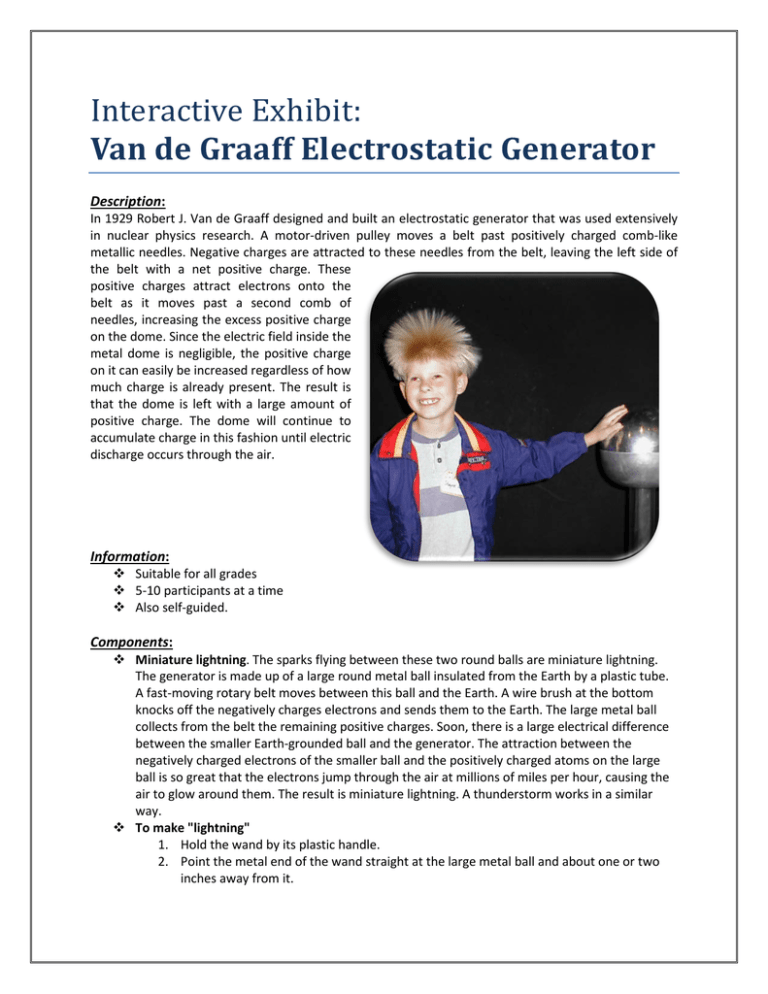Interactive Exhibit: Van de Graaff Electrostatic Generator
advertisement

Interactive Exhibit: Van de Graaff Electrostatic Generator Description: In 1929 Robert J. Van de Graaff designed and built an electrostatic generator that was used extensively in nuclear physics research. A motor-driven pulley moves a belt past positively charged comb-like metallic needles. Negative charges are attracted to these needles from the belt, leaving the left side of the belt with a net positive charge. These positive charges attract electrons onto the belt as it moves past a second comb of needles, increasing the excess positive charge on the dome. Since the electric field inside the metal dome is negligible, the positive charge on it can easily be increased regardless of how much charge is already present. The result is that the dome is left with a large amount of positive charge. The dome will continue to accumulate charge in this fashion until electric discharge occurs through the air. Information: Suitable for all grades 5-10 participants at a time Also self-guided. Components: Miniature lightning. The sparks flying between these two round balls are miniature lightning. The generator is made up of a large round metal ball insulated from the Earth by a plastic tube. A fast-moving rotary belt moves between this ball and the Earth. A wire brush at the bottom knocks off the negatively charges electrons and sends them to the Earth. The large metal ball collects from the belt the remaining positive charges. Soon, there is a large electrical difference between the smaller Earth-grounded ball and the generator. The attraction between the negatively charged electrons of the smaller ball and the positively charged atoms on the large ball is so great that the electrons jump through the air at millions of miles per hour, causing the air to glow around them. The result is miniature lightning. A thunderstorm works in a similar way. To make "lightning" 1. Hold the wand by its plastic handle. 2. Point the metal end of the wand straight at the large metal ball and about one or two inches away from it. Van de Graaff Generator & Lightning - Page 2 of 3 3. Step on the foot switch and hold it down. 4. See and hear miniature lightning bolts jump across the gap. The weather killer. It is estimated that at any given moment, nearly 2,000 thunderstorms are in progress over the Earth's surface and lightning strikes the Earth 100 times a second. Across the United States each year, an average of 150 people die and over 250 are seriously injured from lightning. Over the past 25 years, more people in the U.S. have been killed by lightning than by tornadoes or by hurricanes. More people are killed or injured by lightning in the Southeast than anywhere else in the United States, and Florida leads all other states in lightning deaths each year. Lightning also is responsible for most forest fires and for most electrical blackouts. Property loss is estimated in the hundreds of millions of dollars each year. To calculate the distance of a lightning strike, count the number of seconds from seeing the lightning to hearing the associated thunder. The lightning is one mile distant for every five seconds of delay between the lightning flash and the sound of thunder. If the delay is less than five seconds, then the lightning is less than a mile away and within striking distance. Lightning machines. Winds from a typical thunderstorm brush against the Earth and rise into the center of a thunder cloud. As the winds brush by the Earth, they sweep off electrons from the Earth and take them into the clouds. More and more electrons are deposited on the cloud. The result is a positively charged Earth with a negatively charged cloud. Soon, there are so many electrons on the cloud that they are forced to jump back to Earth. As the electrons rush back to Earth, they light and heat the air to 50,000,000 degrees, and we see it as a flash called lightning. The electrical charges on our Van de Graaff generator are only a few hundred thousand volts. A typical lightning strike carries hundreds of millions of volts of electrical energy . . . enough to kill. Sunshine State Standards Addressed: rd 3 Grade: • 3.P.10.1 Identify some basic forms of energy such as light, heat, sound electrical and mechanical. th 4 Grade: • 4.P.10.1 Observe & describe some basic forms of energy including light, heat sound, electrical and energy of motion. th 5 Grade: • 5.P.10.1 Investigate & describe some basic forms of energy including light, heat sound, electrical, chemical and mechanical. • 5.P.10.3 Investigate & explain that an electrically-charged object can attract an uncharged object and can either attract or repel another charged object without any contact between the objects. • 5.P.10.4 Investigate & explain that electrical energy can be transformed into heat, light, sound and energy of motion. th 6 Grade: • 6.P.13.1 Investigate & describe types of forces including contact forces and forces acting at a distance such as electrical, magnetic and gravitational. th th 9 – 12 Grade: • 912.P.10.1 Differentiate among the various forms of energy and note that they can be transformed from one form to another. • 912.P.10.13 Relate the configuration of static charges to the electric field, electric force, electric Van de Graaff Generator & Lightning - Page 3 of 3 potential and electric potential energy. This project sponsored in part by the State of Florida, Department of State, Division of Cultural Affairs, the Florida Arts Council, and the National Endowment for the Arts.


